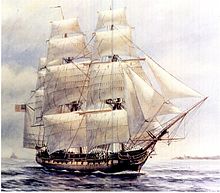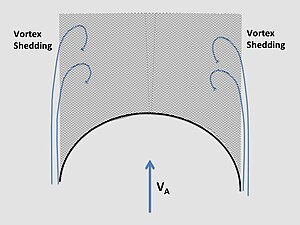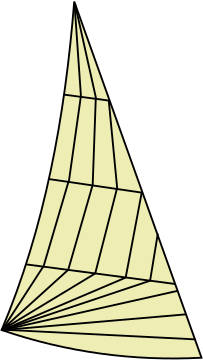Sail
A sail is a
A sail provides propulsive force via a combination of lift and drag, depending on its
Sails may be attached to a mast, boom or other spar or may be attached to a wire that is suspended by a mast. They are typically raised by a line, called a halyard, and their angle with respect to the wind is usually controlled by a line, called a sheet. In use, they may be designed to be curved in both directions along their surface, often as a result of their curved edges. Battens may be used to extend the trailing edge of a sail beyond the line of its attachment points.
Other non-rotating airfoils that power sailing craft include wingsails, which are rigid wing-like structures, and kites that power kite-rigged vessels, but do not employ a mast to support the airfoil and are beyond the scope of this article.
Rigs
Sailing craft employ two types of rig, the square rig and the fore-and-aft rig.
The square rig carries the primary driving sails on horizontal
A fore-and-aft rig consists of sails that are set along the line of the keel rather than perpendicular to it. Vessels so rigged are described as fore-and-aft rigged.[3]
History
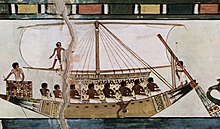
The invention of the sail was a technological advance of equal or even greater importance than the invention of the wheel.[a] It has been suggested by some that it has the significance of the development of the neolithic lifestyle or the first establishment of cities. Yet it is not known when or where this invention took place.[4]: 173
Much of the early development of water transport is believed to have occurred in two main "nursery" areas of the world:
Archaeological studies of the
Square rigs
Sails from
V-shaped square rigs with two spars that come together at the hull were the ancestral sailing rig of the Austronesian peoples before they developed the fore-and-aft crab claw, tanja and junk rigs.[11] The date of introduction of these later Austronesian sails is disputed.[12]
Lateen rigs

Lateen sails emerged by around the 2nd century CE in the Mediterranean. They did not become common until the 5th century, when there is evidence that the Mediterranean square sail (which had been in wide use throughout the classical period) was undergoing a simplification of its rigging components.[b] Both the increasing popularity of the lateen and the changes to the contemporary square rig are suggested to be cost saving measures, reducing the number of expensive components needed to fit out a ship.[13]
It has been a common and erroneous presumption among maritime historians that lateen had significantly better sailing performance than the square rig of the same period. Analysis of voyages described in contemporary accounts and also in various replica vessels demonstrates that the performance of square rig and lateen were very similar. Lateen provided a cheaper rig to build and maintain, with no degradation of performance.[14][13]
The lateen was adopted by Arab seafarers (usually in the sub-type: the settee sail), but the date is uncertain, with no firm evidence for their use in the Western Indian Ocean before 1500 CE. There is, however, good iconographic evidence of square sails being used by Arab, Persian and Indian ships in this region in, for instance, 1519.[15]
The popularity of the caravel in Northern European waters from about 1440 made lateen sails familiar in this part of the world. Additionally, lateen sails were used for the mizzen on early three-masted ships, playing a significant role in the development of the full-rigged ship. It did not, however, provide much of the propulsive force of these vessels – rather serving as a balancing sail that was needed for some manoeuvres in some sea and wind conditions. The extensive amount of contemporary maritime art showing the lateen mizzen on 16th and 17th century ships often has the sail furled. Practical experience on the Duyfken replica confirmed the role of the lateen mizzen.[16][17] [18]
Crab claw rigs
Austronesian invention of

The proto-Austronesian words for sail, lay(r), and some other rigging parts date to about 3000 BCE when this group began their Pacific expansion.[21] Austronesian rigs were distinctive in that they had spars supporting both the upper and lower edges of the sails (and sometimes in between), in contrast to western rigs which only had a spar on the upper edge.[19][20] The sails were also made from salt-resistant woven leaves, usually from pandan plants.[22][23]
Crab claw sails used with
In western
Aerodynamic forces

Left-hand boat:
Down wind—predominant drag propels the boat with little heeling moment.
Right-hand boat:
Up wind (close-hauled)—predominant lift both propels the boat and contributes to heel.

Aerodynamic forces on sails depend on wind speed and direction and the speed and direction of the craft. The direction that the craft is traveling with respect to the true wind (the wind direction and speed over the surface) is called the "point of sail". The speed of the craft at a given point of sail contributes to the apparent wind (VA), the wind speed and direction as measured on the moving craft. The apparent wind on the sail creates a total aerodynamic force, which may be resolved into drag, the force component in the direction of the apparent wind and lift, the force component normal (90°) to the apparent wind. Depending on the alignment of the sail with the apparent wind, lift or drag may be the predominant propulsive component. Total aerodynamic force also resolves into a forward, propulsive, driving force, resisted by the medium through or over which the craft is passing (e.g. through water, air, or over ice, sand) and a lateral force, resisted by the underwater foils, ice runners, or wheels of the sailing craft.[29]
For apparent wind angles aligned with the entry point of the sail, the sail acts as an airfoil and lift is the predominant component of propulsion. For apparent wind angles behind the sail, lift diminishes and drag increases as the predominant component of propulsion. For a given true wind velocity over the surface, a sail can propel a craft to a higher speed, on points of sail when the entry point of the sail is aligned with the apparent wind, than it can with the entry point not aligned, because of a combination of the diminished force from airflow around the sail and the diminished apparent wind from the velocity of the craft. Because of limitations on speed through the water, displacement sailboats generally derive power from sails generating lift on points of sail that include close-hauled through broad reach (approximately 40° to 135° off the wind).[30] Because of low friction over the surface and high speeds over the ice that create high apparent wind speeds for most points of sail, iceboats can derive power from lift further off the wind than displacement boats.[31]
- Downwind sailing with a spinnaker
-
Spinnaker set for a broad reach, mobilizing both lift and drag.
-
Spinnaker cross-section trimmed for a broad reach showing air flow.
-
Spinnaker downwind, primarily mobilizing drag.
-
Spinnaker cross-section with following apparent wind, showing air flow.
Types

| A. Course B. Topsail C. Lateen D. Staysail | E. Gaff-rigged G. Quadrilateral H. Loose-footed J. Spritsail | K. Standing lug L. Triangular M. Dipping lug N. Junk |
Each rig is configured in a
- Jibs, which are usually attached to forestays, and staysails, which are mounted on other stays (typically wire cable) that support other masts from the bow aft.
- Gaff-rigged quadrilateral and Bermuda triangular sails, fore-and-aft sails directly attached to the mast at the luff.
- have their primary attachment to the vessel via a spar.
- Symmetrical spinnakers' primary attachment to a vessel is by a halyard.
High-performance yachts, including the
Shape

The shape of a sail is defined by its edges and corners in the plane of the sail, laid out on a flat surface. The edges may be curved, either to extend the sail's shape as an airfoil or to define its shape in use. In use, the sail becomes a curved shape, adding the dimension of depth or draft.
- Edges – The top of all sails is called the head, the leading edge is called the luff on fore-and-aft sails[37] and on windward leech symmetrical sails, the trailing edge is the leech, and the bottom edge is the foot. The head is attached at the throat and peak to a gaff, yard, or sprit.[38] For a triangular sail the head refers to the topmost corner.[37]
- A fore-and-aft triangular mainsail achieves a better approximation of a wing form by extending the leech aft, beyond the line between the head and clew on an arc called the roach, rather than having a triangular shape. This added area would flutter in the wind and not contribute to the efficient airfoil shape of the sail without the presence of battens.[39] Offshore cruising mainsails sometimes have a hollow leech (the inverse of a roach) to obviate the need for battens and their ensuing likelihood of chafing the sail.[40] The roach on a square sail design is the arc of a circle above a straight line from clew to clew at the foot of a square sail, which allows the foot of the sail to clear stays coming up the mast, as the sails are rotated from side to side.[41]
- Corners – The names of corners of sails vary, depending on shape and symmetry. In a triangular sail, the corner where the luff and the leech connect is called the head.[42][37] On a square sail, the top corners are head cringles, where there are grommets, called cringles.[43] On a quadrilateral sail, the peak is the upper aft corner of the sail, at the top end of a gaff or other spar. The throat is the upper forward corner of the sail, at the bottom end of a gaff or other spar. Gaff-rigged sails, and certain similar rigs, employ two halyards to raise the sails: the throat halyard raises the forward, throat end of the gaff, while the peak halyard raises the aft, peak end.[44]
- The corner where the leech and foot connect is called the clew on a fore-and-aft sail. On a jib, the sheet is connected to the clew; on a mainsail, the sheet is connected to the boom (if present) near the clew.[37] Clews are the lower two corners of a square sail. Square sails have sheets attached to their clews like triangular sails, but the sheets are used to pull the sail down to the yard below rather than to adjust the angle it makes with the wind.[44] The corner where the leech and the foot connect is called the clew.[37] The corner on a fore-and-aft sail where the luff and foot connect is called the tack[37] and, on a mainsail, is located where the boom and mast connect.[37]
- In the case of a symmetrical spinnaker, each of the lower corners of the sail is a clew. However, under sail on a given tack, the corner to which the spinnaker sheet is attached is called the clew, and the corner attached to the spinnaker pole is referred to as the tack.[44][45] On a square sail underway, the tack is the windward clew and also the line holding down that corner.[46]
- Draft – Those triangular sails that are attached to both a mast along the luff and a boom along the foot have depth, called staysails by adjustment of the sheets and the angle from which they reach the sails.[47]
Material
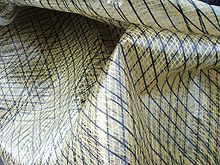
Sail characteristics derive, in part, from the design, construction and the attributes of the fibers, which are woven together to make the sail cloth. There are several key factors in evaluating a fiber for suitability in weaving a sail-cloth:
Traditionally, sails were made from
Construction
Cross-cut sails have the panels sewn parallel to one another, often parallel to the foot of the sail, and are the least expensive of the two sail constructions. Triangular cross-cut sail panels are designed to meet the mast and stay at an angle from either the warp or the weft (on the bias) to allow stretching along the luff, but minimize stretching on the luff and foot, where the fibers are aligned with the edges of the sail.[51]
Radial sails have panels that "radiate" from corners in order to efficiently transmit stress and are typically of higher performance than cross-cut sails. A bi-radial sail has panels radiating from two of three corners; a tri-radial sail has panels radiating from all three corners. Mainsails are more likely to be bi-radial, since there is very little stress at the tack, whereas head sails (spinnakers and jibs) are more likely to be tri-radial, because they are tensioned at their corners.[48]
Higher performance sails may be laminated, constructed directly from multiple plies of filaments, fibers, taffetas, and films, instead of woven textiles that are adhered together. Molded sails are laminated sails formed over a curved mold and adhered together into a shape that does not lie flat.[48]
Conventional sail panels are sewn together. Sails are tensile structures, so the role of a seam is to transmit a tensile load from panel to panel. For a sewn textile sail this is done through thread and is limited by the strength of the thread and the strength of the hole in the textile through which it passes. Sail seams are often overlapped between panels and sewn with zig-zag stitches that create many connections per unit of seam length.[48][52]
Whereas textiles are typically sewn together, other sail materials may be
Sails feature reinforcements of fabric layers where lines attach at grommets or cringles.[43] A bolt rope may be sewn onto the edges of a sail to reinforce it, or to fix the sail into a groove in the boom, in the mast, or in the luff foil of a roller-furling jib.[41] They may have stiffening features, called battens, that help shape the sail, when full length,[53] or just the roach, when present.[39] They may have a variety of means of reefing them (reducing sail area), including rows of short lines affixed to the sail to wrap up unused sail, as on square and gaff rigs,[54] or simply grommets through which a line or a hook may pass, as on Bermuda mainsails.[55] Fore-and-aft sails may have tell-tales—pieces of yarn, thread or tape that are affixed to sails—to help visualize airflow over their surfaces.[39]
- Comparison of jib panel construction
-
Cross-cut
-
Bi-radial
-
Tri-radial
Running rigging

- Main sheet
- Jib sheet
- Boom vang
- Downhaul
- Jib halyard

The lines that attach to and control sails are part of the running rigging and differ between square and fore-and-aft rigs. Some rigs shift from one side of the mast to the other, e.g. the dipping lug sail and the lateen. The lines can be categorized as those that support the sail, those that shape it, and those that control its angle to the wind.
Fore-and-aft rigged vessels
Fore-and-aft rigged vessels have rigging that supports, shapes, and adjusts the sails to optimize their performance in the wind, which include the following lines:
- Supporting – Halyards raise sails and control luff tension. Topping lifts hold booms and yards aloft.[56] On a gaff sail, brails run from the leech to the spar to facilitate furling.[57]
- Shaping – Barber haulers adjust a spinnaker/jib sheeting angle inboard at right angles to the sheet with a ring or clip on the sheet attached to cordage which is secured and adjusted via fairlead and cam cleat.[58] Kicking straps/boom vangs control a boom-footed sail's leech tension by exerting downward force mid-boom.[56] Cunninghams tighten the luff of a boom-footed sail by pulling downward on a cringle in the luff of a mainsail above the tack.[59] Downhauls lower a sail or a yard and can adjust the tension on the luff of a sail.[56] Outhauls control the foot tension of a boom-footed sail.[56]
- Adjusting angle to the wind – Sheets control angle of attack with respect to the apparent wind, the amount of leech "twist" near the head of the sail, and the foot tension of loose-footed sails.[56] A preventer attaches to the end of the boom from a point near the mast to prevent an accidental gybe.[56] Guys control spinnaker pole angle with respect to the apparent wind.
Square-rigged vessels
Square-rigged vessels require more controlling lines than fore-and-aft rigged ones, including the following.
- Supporting – Halyards raise and lower the yards.leech (outer vertical edges) of a sail and serve to pull the leech both in and up when furling.[57]
- Shaping – Bowlines run from the leech forward towards the bow to control the weather leech, keeping it taut and thus preventing it from curling back on itself.[57] Clewlines raise the clews to the yard above.[57]
- Adjusting angle to the wind – Braces adjust the fore and aft angle of a yard (i.e. to rotate the yard laterally, fore and aft, around the mast).[57] Sheets attach to the clew to control the sail's angle to the wind.[57] Tacks haul the clew of a square sail forward.[57]
Gallery
Sails on high-performance sailing craft.
-
Windsurfer.
-
ice boat.
-
Land sailing craft.
Sails on craft subject to low forward resistance and high lateral resistance typically have full-length battens.[53]
See also
|
|
|
|
Legend
Notes
- ^ The wheel was invented c.5,000BCE [4]: 174
- ^ An obvious component of the Mediterranean square sail in archaeological situations are the lead rings through which brail lines were led. The brails were used to reduce sail area in rising winds. The cheaper alternative was to use reefing points (as is seen in traditional sailing craft of today), with the archaeological record seeing a disappearance of the distinctive lead rings.
References
- ^ Oxford English Dictionary
- ISBN 0-670-81416-4.
- ^ Knight, Austin Melvin (1910). Modern seamanship. New York: D. Van Nostrand. pp. 507–532.
- ^ ISBN 978-0-8173-9075-4.
- ISBN 9781781593929.
- ISBN 9781473825598.
- ISBN 978-0-520-25398-8.
The use of sailing-boats is attested from the sixth millennium onwards by their incised depiction on ceramics.
- ISBN 978-1-4051-8988-0. Archivedfrom the original on 28 April 2015. Retrieved 8 February 2014.
- Yale. Archived from the originalon 2011-02-01. Retrieved 2010-08-24.
- ^ The sea-craft of prehistory, p76, by Paul Johnstone, Routledge, 1980
- from the original on 2023-06-06. Retrieved 2022-06-03.
- ISBN 978-0-19-992507-0.)
{{cite book}}: CS1 maint: location missing publisher (link - ^ S2CID 161464823.
- S2CID 111007423.
- ISBN 9788785180704.
- .
- ISBN 0851775608.
- ISBN 0851775608.
- ^ a b c Doran, Edwin Jr. (1974). "Outrigger Ages". The Journal of the Polynesian Society. 83 (2): 130–140. Archived from the original on 2019-06-08. Retrieved 2019-10-16.
- ^ ISBN 978-0-415-10054-0.[dead link]
- ISBN 0-8248-1582-3.
- ISBN 978-0-520-95383-3.
- ISBN 978-0-8248-4093-8.
- ISBN 978-0-89096-107-0.
- PMID 21345865.
- JSTOR 20702413.
- ^ Hourani, George Fadlo (1951). Arab Seafaring in the Indian Ocean in Ancient and Early Medieval Times. New Jersey: Princeton University Press.
- ISBN 978-0-674-79595-2.
- ^
Clancy, L.J. (1975), Aerodynamics, London: Pitman Publishing Limited, p. 638, ISBN 0-273-01120-0
- ISBN 0-312-04278-7.
- ^
Bethwaite, Frank (2007). High Performance Sailing. Adlard Coles Nautical. ISBN 978-0-7136-6704-2.
- ^ Clerc-Rampal, G. (1913) Mer : la Mer Dans la Nature, la Mer et l'Homme, Paris: Librairie Larousse, p. 213
- ^
Folkard, Henry Coleman (2012). Sailing Boats from Around the World: The Classic 1906 Treatise. Dover Maritime. Courier Corporation. p. 576. ISBN 978-0-486-31134-0. Archivedfrom the original on 2017-11-11.
- ^ Nielsen, Peter (May 14, 2014). "Have Wingsails Gone Mainstream?". Sail. Archived from the original on April 12, 2015. Retrieved 2015-01-24.
- ^ "America's cup: BMW Oracle Racing pushes edge in 90-foot trimaran". International Herald Tribune. 2008-11-08. Archived from the original on 2008-12-11. Retrieved 2009-03-07.
- ^ Swintal, Diane (13 August 2009). "Russell Coutts Talks About BMW Oracle's Giant Multi-hull". cupinfo.com. Archived from the original on 17 February 2012. Retrieved 2012-04-25.
- ^ a b c d e f g "Know How: Sailing 101". Sail Magazine. Archived from the original on 5 October 2016. Retrieved 4 October 2016.
- ^ King, Hattendorf & Estes 2000, p. 283.
- ^ a b c d e
Textor, Ken (1995). The New Book of Sail Trim. Sheridan House, Inc. p. 228. ISBN 0-924486-81-3. Archivedfrom the original on 2016-05-17.
- ^
Nicolson, Ian (1998). A Sail for All Seasons: Cruising and Racing Sail Tips. Sheridan House, Inc. p. 124. ISBN 978-1-57409-047-5. Archivedfrom the original on 2017-11-11.
- ^ a b Kipping, Robert (1847). The Elements of Sailmaking: Being a Complete Treatise on Cutting-out Sails, According to the Most Approved Methods in the Merchant Service... F.W. Norie & Wilson. pp. 58–72.
- ISBN 978-1-4391-3678-2. Archivedfrom the original on 2017-11-11.
- ^ a b
Knight, Austin N. (1921). Modern Seamanship (8 ed.). New York: D. van Nostrand Company. pp. 831.
head cringle.
- ^ ISBN 978-0-8050-6615-9. Archivedfrom the original on 2017-11-11.
- ^ "Sailing Quick Reference Guide" (PDF). Wayzata Yacht Club. Archived (PDF) from the original on 5 January 2017. Retrieved 4 October 2016.
- ^ King, Hattendorf & Estes 2000, p. 416.
- ^ Jinks, Simon. "Adjusting Sail Draft". Royal Yachting Association. Archived from the original on 5 October 2016. Retrieved 4 October 2016.
- ^ a b c d e f
Hancock, Brian; Knox-Johnson, Robin (2003). Maximum Sail Power: The Complete Guide to Sails, Sail Technology, and Performance. Nomad Press. pp. 288. ISBN 978-1-61930-427-7.
sail panel cut.
- ^
Wool Sailcloth, Vikingeskibs Museet, retrieved 2024-03-15
{{citation}}: CS1 maint: url-status (link) - ^ Rice, Carol (January 1995), "A first-time buyers checklist", Cruising World, vol. 21, pp. 34–35, from the original on 2017-11-11, retrieved 2017-01-13
- ^
Colgate, Stephen (1996). Fundamentals of Sailing, Cruising, and Racing. W. W. Norton & Company. p. 384. ISBN 978-0-393-03811-8. Archivedfrom the original on 2017-11-11.
- ^ ISBN 978-0-85709-396-7, archivedfrom the original on 2023-11-04, retrieved 2017-01-12
- ^ a b
Berman, Phil (1999). Catamaran Sailing: From Start to Finish. W. W. Norton & Company. pp. 219. ISBN 978-0-393-31880-7.
Catamaran batten.
- ^
Cunliffe, Tom (2004). Hand, Reef and Steer. Sheridan House, Inc. p. 178. ISBN 978-1-57409-203-5. Archivedfrom the original on 2017-11-11.
- ISBN 978-1-57409-198-4. Archivedfrom the original on 2023-11-04. Retrieved 2020-10-20.
- ^ ISBN 978-1-57409-093-2. Archivedfrom the original on 2023-11-04. Retrieved 2020-10-20.
- ^ a b c d e f g h i j
Biddlecombe, George (1990). The Art of Rigging: Containing an Explanation of Terms and Phrases and the Progressive Method of Rigging Expressly Adapted for Sailing Ships. Dover Maritime Series. Courier Corporation. pp. 155. ISBN 978-0-486-26343-4.
The Art of Rigging: Containing an Explanation of Terms and Phrases and the ... By George Biddlecombe.
- ISBN 978-1-57409-220-2. Archivedfrom the original on 2023-11-04. Retrieved 2020-10-20.
- ISBN 978-1-4081-8800-2. Archivedfrom the original on 2023-11-04. Retrieved 2020-10-20.
Further reading
- Chapman Piloting & Seamanship. Maloney, Elbert S., Chapman, Charles F. (Charles Frederic), 1881-1976. (65th ed.). New York: Hearst Books. 2006. )
- Crothers, William L. (2014). The Masting of American Merchant Sail in the 1850s An Illustrated Study. Jefferson, North Carolina: McFarland Publishing. ISBN 978-0-7864-9399-9.
- Hancock, Brian. (2003). Maximum Sail Power : the Complete Guide to Sails, Sail Technology, and Performance (PDF). New York: Nomad Press. OCLC 913696173. Archived from the original(PDF) on 2022-04-16. Retrieved 2020-05-09.
- The Sailor's Handbook : The Essential Sailing Manual. Herreshoff, Halsey C. [Place of publication not identified]: International Marine. 2006. )
- Jobson, Gary. (8 September 2008). Sailing Fundamentals : The Official Learn-to-Sail Manual of the American Sailing Association and the United States Coast Guard Auxiliary. Betz, Marti., American Sailing Association., United States. Coast Guard Auxiliary. (Revised and updatedition ed.). New York. )
- Marchaj, C. A. (Czesaw Antony), 1918- (2003). Sail Performance: Techniques to Maximise Sail Power (Rev. ed.). London: Adlard Coles Nautical. )
- Marino, Emiliano. (2001). The Sailmaker's Apprentice : A Guide for the Self-Reliant Sailor. Camden, Me.: International Marine. OCLC 48258636.
- Rousmaniere, John (7 January 2014). The Annapolis Book of Seamanship. Smith, Mark (Mark E.) (Fourth ed.). New York. )
- Seidman, David. (2011). The Complete Sailor : Learning the Art of Sailing (2nd ed.). Camden, Me.: International Marine/McGraw-Hill. OCLC 704984188.
External links
- Sailboats database: sailing yacht specifications worldwide
- Sail Design Software
- The quest for the perfect sailshape Archived 2012-03-02 at the Wayback Machine
- FABRIC Sail Design Software
- Laminated Sails: Doyle Stratis Archived 2012-03-14 at the Wayback Machine
- . . 1914.

